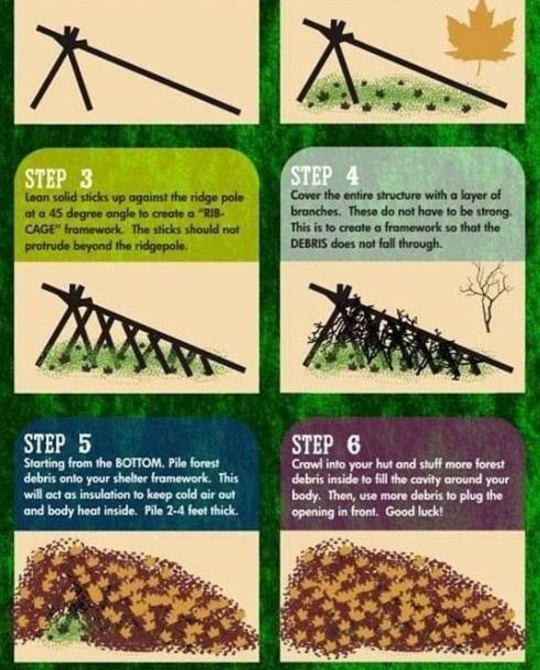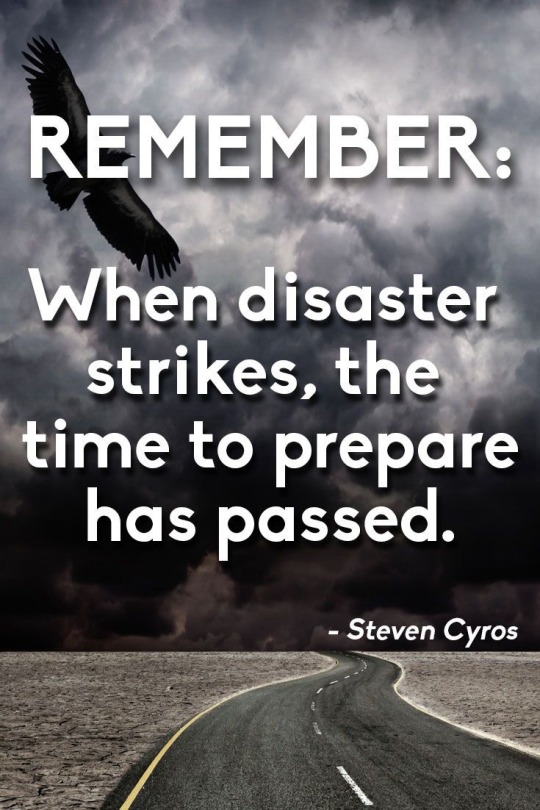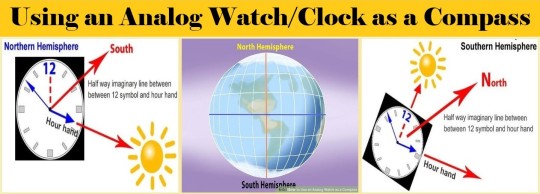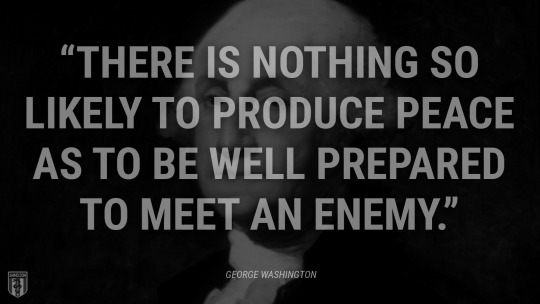#prepping
Text






Helpful things I've saved over the years
#hiking#camping#prepping#outdoors#nature#naturecore#prep#prepper#helpful#tips#diy#survival#survival tips#apocalypse#bug out#lol#funny#memes#meme#haha
288 notes
·
View notes
Text



270 notes
·
View notes
Text

#preparedness saturday#prepper#women preparedness#prepping#emergency preparedness#shtf#preparedness quote
69 notes
·
View notes
Text
Heads up east coast
They are calling for a bad winter, almost if not just as bad as what happened to Texas a few years ago.
So start stocking up. I recommend starting with these:
Toilet paper (not all at once! Maybe just an additional small pack every time you get more. Flushable wipes are also good)
Period products
Canned goods
Gallons of water (Aldis has some for about $0.85
A small tent (if you can. Check Walmart.) If the power goes out, popping a small tent inside can help keep you a little warmer. If I remember correctly, inside the tent can be about 10° warmer.
A cold weather sleeping bag. (I got one for 30° weather from Walmart for under $25) if it's too big, stuff blankets at the bottom
Socks, socks, socks
At least 3 sources of fire (matches, lighters, etc)
Solar powered charging blocks
Batteries
Candles
Possibly a small camping stove (if you use this inside be careful.
If you have a fire place, make sure that shit is cleaned now. (I also encourage you to start collecting lint from the dryer as a fire starter
Tape cellophane over the windows to help with drafts.
Try to get boots or water proof your boots
Salt for the ground
Jarred goods
Find your local food pantries if you are worried about running out of food.
When it gets to freezing Temps, let your taps run a bit at night so they down explode. This can happen even while the power is on, I believe.
And if you can, donate to your local food pantry. Especially diapers. Donate coats. Don't forget the homeless and low income who are going to be in extreme danger.
Anyone else have anything I might have missed?
202 notes
·
View notes
Photo

Government Oversight Brief: Anti-Militia Bill The Preventing Private Paramilitary Activity Act has been introduced by a U.S. Senator and U.S. Representative in an effort to limit and criminalize civilian militias. If passed the law would "hold individuals liable who directly engage in certain types of conduct, including intimidating state and local officials, interfering with government proceedings, pretending to be law enforcement, and violating people’s constitutional rights, while armed and acting as part of a private paramilitary organization". The lawmakers presenting the act say there are no federal laws against such militias as regulations have been left to the states. Writers of the act say "military organizations pose a threat not only to national security, but they also present a public safety problem that extends beyond any single state; for example, private paramilitary actors like the Proud Boys and Oath Keepers traveled across state lines on January 6th". A member of the U.S. House who introduced the bill claims that militias are "patrolling neighborhoods, impeding law enforcement and storming the U.S. Capitol, private paramilitary groups like the Oath Keepers, the Three Percenters and the Proud Boys are using political violence to intimidate our people and threaten democratic government and the rule of law". A private paramilitary organization is described as any group of 3 or more persons associating under a command structure for the purpose of functioning in public or training to function in public as a combat, combat support, law enforcement, or security services unit. The act would preempt state law if any "provision of State law is inconsistent with any of the purposes of this chapter'. Lawmakers advised that the act would "provide tools necessary to deter and prevent paramilitary efforts" that were previously "protected by the First and Second Amendments". Supporters claim that the U.S. Constitution, which reads in part "A well regulated Militia, being necessary to the security of a free State, the right of the people to keep and bear Arms, shall not be infringed" has been "falsely" applied and that such protections must be infringed
104 notes
·
View notes
Text

Use an Analog Clock as a Compass:
Using a Watch to Find North: The watch method for navigation is useful for finding the cardinal directions of: north, south, east and west. While not being 100 percent accurate, it is handy for crude navigation when a compass is not available and can head you in the correct general direction in camping, bushcraft, backpacking and survival situations. It is also useful in combination with other natural navigation methods found in this link and other resources.
If Located in the Northern Hemisphere:
Align a twig (pointing up) at the edge of your watch so that it casts a shadow onto the face of the watch from the Sun.
Rotate the watch until the twig's shadow (the Sun) is cast directly onto the hour hand.
The halfway point between the hour hand and the 12-oclock mark is your North-South line. Note that during Daylight Saving Time (or Summer Time), your watch is most likely one hour "off" from the "real" time. If this is the case, substitute 1 o'clock for 12 o'clock before finding your North-South line.
The halfway imaginary line will point to South
If only a digital clock is available, draw an analog/dial clock (with the correct time) on paper or in the dirt.
If Located in the Southern Hemisphere:
Align a twig (pointing up) at the edge of your watch so that it casts a shadow onto the face of the watch from the Sun.
Rotate the watch until the twig's shadow (the Sun) is cast directly onto the 12-oclock mark.
The halfway point between 12-oclock and the hour hand is your North-South line. Note that during Daylight Saving Time (or Summer Time), your watch is most likely one hour "off" from the "real" time. If this is the case, substitute 1 o'clock for 12 o'clock before finding your North-South line.
The halfway imaginary line will point to North.
If only a digital clock is available, draw an analog/dial clock (with the correct time) on paper or in the dirt.
[Reference Link]
Related Resources:
Survival Navigation - Find Your Way Out
Wilderness Shelter
Fire Building for Cooking, Heat and Light
Finding, Collecting and Purifying Water in the Wilderness
Handling Injuries, Illness and First Aid in the Wild
[14-Point Emergency Preps Checklist]
[11-Cs Basic Emergency Kit]
[Learn to be More Self-Sufficient]
[The Ultimate Preparation]
[5six7 Menu]
#navigation#compass#prepare4tomorrow#prepper#survival#shtf#lost#clock as compass#compass from a clock#finding directions#campsite#camping#explore#analog watch#prepping#directions#find home#hiking#bushcraft#homesteading#wilderness
96 notes
·
View notes
Text

Download link is at the bottom of the post
#prepping#prepper#shtf#preparedness#survival#survive#survivaltips#self sufficiency#self sufficient living#self sustaining#farming
103 notes
·
View notes
Text
29 notes
·
View notes
Text
Prepping for NaNoWriMo by slamming my head against a wall.
77 notes
·
View notes
Text
What To Do In Tornados
I’ve lived in tornado country pretty much my whole life and to be honest they still freak me out. I also remember how anxiety inducing it was when I first moved out and had to deal with them on my own. So like a message in a bottle to my former self, I wanted to compile what I’ve learned over the years in a skimmable format in case there’s anyone else out there today who could use it.
Difference between a watch and a warning?
Tornado watch means you have time; think of a wrist watch. Tornado warning means one is incoming, no more time. This is the one I use to remember it.
Or if you prefer the Weather Channels very memeable explanation - tornado watch means you have taco (tornado) ingredients - picture a taco bar. Tornado warning means you have a fully assembled taco (tornado). This is what my partner uses.
So there are possible tornados in the forecast:
Make a plan about where you’ll go if you get a warning. It should be the most interior room in your house, well away from any windows. Here we have a walkout basement and I go to the most interior part of it. When I was in an apartment, the most interior room happened to be my bathroom and hallway. If you live in a dorm or other communal setting, they should have a plan in place so make sure to find out what it is.
Take pictures of your rooms and car in the event you need to file an insurance claim. Having pictures of what you own, it’s condition is helpful for filing insurance claims if you need to. Especially if you’re a renter. This is easiest to do when there’s no storms in your area so you aren’t nervous or pressed for time.
Make a power outage plan. A lot of the threat that comes with tornados is not from the tornados themselves but the damaging straight line winds around the tornado. Whenever there’s high winds, there’s a chance to lose power. Consider how you’d eat, drink, go to the bathroom, and stay warm in the event of a power outage. Less necessary but still helpful - consider how you’ll entertain yourself, especially if cell towers go down or you need to conserve your phone battery. Consider what chores - like laundry or dishes - would be good to have out of the way before hand.
Grab snacks and food that doesn’t need refrigeration. If you’re able to make a grocery store run, grab some food you can eat that is shelf stable and doesn’t require cooking. A good rule of thumb in my experience is three days worth. Most power outages I’ve been through have been fixed in that time and you can more safely evacuate then if you need to go somewhere with power. If you’re like me and have a lot of food allergies (gluten, dairy, soy) - consider baking items ahead of time that can keep well at room temperature like cookies, scones, and breads.
So you’ve been issued a Tornado Watch:
Check the forecast; you might have lots of time before the storms will be in your area or you might have very little.
Make a plan if you haven’t already. Or check your building’s plan if you live in a dorm or communal setting.
Make sure everyone involved knows the plan. Don’t assume people you’re with know. I have made that mistake before.
Charge your phone and electronics. If you don’t currently have a thunderstorm in your area, go ahead and charge your phone, power bank, flashlights, and anything else you’ll want to take with you your safe spot.
Gather supplies to take with you to your safe spot
Minimum:
Shoes
Phone
Form of ID*
Leash/Harness/Cage for pets
Explanation of minimum:
Shoes are important because if you need to evacuate, there’s likely broken glass and other things on the floor that can injure you. If you can’t safely move through it, then people will have to come escort you out which means waiting longer + more risk.
Phone is important for calling for help and receiving alerts. Also many can double as a flashlight in a pinch.
*ID is helpful accessing emergency housing and medical services if you have to leave your home. If your ID doesn’t list your residence or you don’t have/want to have ID documents on you for safety reasons, consider grabbing a copy of your lease or some mail addressed to you there. You can still access services without this, it just helps speed stuff up.
Keeping pets on a leash or cage helps keep them safe in the event you need to evacuate with them.
If you can:
Tote bag
Helmet
Flashlight
Power bank + cord
Weather radio
Water bottles
Some pet food + bowl
Snacks
I put all my supplies in a little tote bag. It’s my storm tote (conference bag I’m never gonna use for anything else).
Helmet is pretty self explanatory. One more way to keep your head safe in case anything falls on you.
Flashlights help you move around your house if it’s safe to stay in if the power goes out. In the event your house is unsafe, it helps you safely evacuate. If you’re trapped, it helps you signal for help.
Power bank + cord helps you recharge your phone if the power goes out. When you’re checking alerts and watching streams, the battery can deplete quickly.
Weather radios of any kind is helpful. Cell service often goes out so the way you’ll get your information then will be primarily through radio. If you’re reading this not in a watch and want to get one, look for ones that will wake you up if there’s a warning in your area. Midland has several. I have a small Sony radio I take with me to my safe spot.
Water bottles are helpful because they’re highly portable and in the unlikely event you get trapped in your house, you’ll have water to keep you hydrated while help gets to you.
Pet food is so you can feed your animal without leaving your safe spot since warnings can last a long time. I’ve seen some areas be warned for 1-2 hours before if a storm is slow moving enough. But it’s also so you’ll have some food for them in the event you need to evacuate.
Snacks are similar to pet food. It’s you food. Just helps you shelter in place.
So you’ve been issued a Tornado Warning:
Put on your shoes
Put pets on harnesses and a leash or in a cage
Go to your safe spot and don’t come out until the warning has expired
Especially if the warning is PDS or has some other enhanced tag, try to bring something to cover your head and body with - like a mattress. A thick blanket is better than nothing in a pinch.
127 notes
·
View notes
Text





#prepping#survival#food storage#cooking#food preservation#nuclear#self sufficiency#war garden#victory garden#vegetables#planting#spring
13 notes
·
View notes
Text
Ok, not my usual post.
My friend Tina (FarmGirlInMiddleOfNowhere) who use to be on here and I was talking about things that have been going on in the world today.
Due to the uncertainty in the world, she asked if I would post something that she use to post a couple times a year for the ladies on Tumblr. I had to look up a different site than she used, since the one she use to post is no longer online. So here it is.
How to make homemade feminine pads.
Tina asked me to pass on:
Please share with others. This can be a way to save money, to have emergency back-up until you can get back to the store or to have on hand if everything hits the fan and stores are closed for a long time. Or just copy/download the pattern and instructions and put them with the rest of your patterns for later.
170 notes
·
View notes
Text

#preparedness saturday#preparation#preparedness quote#preppers#prepping#emergency preparedness#self defense
70 notes
·
View notes
Text
Hosted a virtual event tonight. Topic was "3 day, winter evacuation go bag". It was a lot of fun.
I brought some gear to encourage discussion.
And yes, I finally got to make a pulk sled. It's featured in the display.

Recap, in case anyone was curious the kinds of things we talked about. Off the top of my head so stuff's missing and out of order.
This evening's event was mainly just kicking things off. Some things we touched on:
- Start with what you have on hand.
- We cant necessarily be ready for every scenario. But some items we'll need no matter the scenario. Those are prime items for a go-bag.
- Making an evacuation plan in advance, with family/those providing necessary transportation, etc.
- How to layer clothes for winter.
- Wool & Wool Sensitivities: Lanolin, Chromium, Formeldahide may cause reactions to wool. But if one's itchiness is only caused by the diameter of the wool fibers, a smaller wool fiber, like Merino, may not be itchy. Synthetic baselayer alternatives exist, like Capilene (spelling?).
- Make a go-list. We cant always store a C-pap etc in a go bag if we use it in daily life. But if we have a list of grab-items ahead of time, we can be ready to evacuate faster.
- We need a different meeting time.
- 30 day supply of emergency medication is ideal. But even one extra day is better than none. It gives us another day to find more.
- AM/FM radio can help us keep tabs on situation updates, as well as information such as where we can evacuate to. Some models are hand crank and let us recharge our electronics. But even a simple, $10 battery operated AM/FM is a GREAT idea.
- Food and water help protect us from hypothermia.
- Save money. Look for free items. Wait for sales.
- In an emergency, contrary to fictional movies, communities tend to band together and find ways to help each other.
- After a big earthquake, don't immediately run outside. Pause to assess the situation. Look for things that might fall on you from above, both inside and outside of the building.
- More discussions can help desensitize us and reduce anxiety when engaging with the topic.
Items people introduced to the group:
- Life Straw, a small, portable, emergency water filter.
- Top Ramen, nearly 400calories, lightweight, inexpensive.
- MSR Firefly, multi-fuel stove with flame adjuster. Works with several different types of fuel. Can be repaired in the field. Good even in high altitudes and below freezing temperatures.
#go-bags#winter go-bag#disaster preparedness#disaster preparation#community prepper#prepping#evacuation
21 notes
·
View notes
Text

Couples Defense: Staying Safe Together:
Committing to help one another, as a couple, family or team of like-minded individuals to stay safe, gather supplies, plan and prepare physically and emotionally is a vital skill to learn.
Forget the chocolate and flowers! What better way to say I love you than to commit to staying safe with your partner by doing these things together:
Plan Ahead
Learn How to Defend Each Other
Get in Shape, Stay in Shape and Eat Healthy
Encourage One Another to Ditch Unhealthy and Wasteful Habits
Prepare for Anything
Know Basic First Aid and Build Your Prevention Medicine Cabinet
Learn the Basics Together
Include Pets in the Planning
[Reference Link]
RELATED RESOURCES:
Why Plan for an Emergency
Prepping Your Spouse for a Preparedness Lifestyle
How to Prep When Your Significant Other or Family Objects
The Best People to Be Friends with Before SHTF
How to Find Survivalist Friends
How your friends can influence your mood and behavior
Helping Others Help Themselves
Emergency Planning with Like-Minded Companions
Why Join or Start a Survival Group?
The Law of Attraction
Importance of a Buddy System
Personal Benefits of Volunteering
Know Your Neighborhood - The Lay of the Land
Emergency Prepping for Seniors and Mobility Challenged
Animals for Emergency Companions and Defense
Body Language: Reading Non-Verbal's and Building Trust
No Sense of Community in Modern Society
The Lone Wolf Prepper
[14-Point Emergency Preps Checklist]
[11-Cs Basic Emergency Kit]
[Learn to be More Self-Sufficient]
[The Ultimate Preparation]
[5six7 Menu]
#companionship#survival companions#prepper#survival#survival team#couple#couples#shtf#companions#spouse#prepping with spouse#prepping objections#prepping with others#prepping with family#family prepping#couples survival#couples defense#couples emergency survival#camping#hiking#homesteading#prepping#prepare4tomorrow#bushcraft#lone wolf
37 notes
·
View notes
Text
Bushcraft 101: A Field Guide to the Art of Wilderness Survival (FREE) ePUB
71 notes
·
View notes